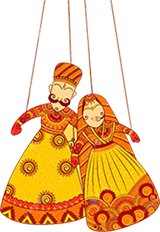Handicrafts of Rajasthan
Rajasthan is among the richest state of India in terms of handicraft items. Each little village has its own craftsmen patronised by the local peoples. The craftsmen of the state have been creating the most opulent and richest treasures. Stone, clay, leather goods, ivory, lac, brass, gold and textiles are given the most brilliant shapes and forms.
The beauty of Rajasthan lies in abundant traditional crafts making skills. The fine works of producing the swords and the knives with a certain degree of sharpness for the royal kings and warriors represent their ability to carve out rare crafts since the earlier days. In the present context, these artisans are mainly producing goods for the large number of tourists visiting the state of Rajasthan round the year.
Stone Sculpting: Fine quality of marble and sandstone sculptors are created by the best stone masons and sculptor. Deities of the god and goddesses are carved out very intrinsically. The finest sculptors work upon the temples of Rajasthan in the days of the Rajah's and some of the best work includes the temples of Dilwara in Mount Abu. Marble carving is prominent in Jaipur. Artisans are seen working upon images of deities, domestic utensils such as bowls for grinding spices and kneading.
Pottery: It was from Rudrapal, the first potter that the potter caste came to, be known as Kumbhars and was believed to be created by Lord Shiva. Rajasthan Pottery has a long lineage with fragments found in Kalibanga of the Harrapan Civilization dating back to the 2500BC. The most famous is the blue potter of Jaipur. Originated in china, it was passed on from the Persian to the Muslims. In the Molela region, north of Udaipur potters work with terracotta formed from clay and donkey's dung.
Textile:The whole of Rajasthan get coloured with its vibrant textiles. Cotton is produced by the Julaha caste known as Masuria. Clothes made in the Kaithoon village in Kota district are the most highly priced. Both cotton and silk is used in the making. Saris made out of this cloth fetch a good price around the country. The clothes are given treatments like rich blaze of colour, dying, block printing and numerous forms of embroidery and appliqué. Bandhani is the most intricate tie dying process. Parts of the fabric are knotted and on dying the knotted section retain the original colour. The dyes were in old days derived from natural sources such as vegetables, minerals and insects.
Carpets and Weaving:The Muslims brought the art of Carpet making in to the country. Carpet weaving stated in the 16th century and initially small mats called jajams were created on which one person can comfortably sit. In the city of Jaipur, pile carpets were produced under the guidance of the Persian weavers. Some of the beautiful dhuries or the flat cotton carpets were first produced by the prisoners in Jail. Shawls are woven too in the desert region out of hand-spun wool called as kheis.
Jewellery:Silver jewellery is prominent in the villages of Rajasthan and peoples can be seen decked in elaborate ornaments of silver bracelets, rings, nose rings, toe rings, ankle bracelets, and pendants worn on the fore head. The ornaments indicate the caste of the village men in the regions. The other prominent work is the enamel work called as Meenakari that features floral and animal design. Both silver and gold can be used as base for meenakari and the final piece is a masterly art in the hands of the sonar, the goldsmith, the chattera and the enameller.
Woodwork:Shekhawati is an important centre for wood carving. Finely wrought doors, window panes, pidas or the low folding chairs with decorative carvings, latticed screen windows are found in the region. Lacquered wares are produced in most part of the state including Jaipur, Jodhpur, Sawai Madhopur and Udaipur and are known widely for the lac bangles and bracelets.









